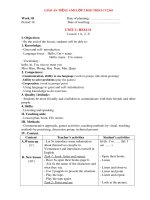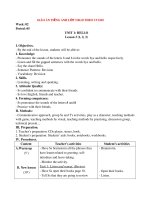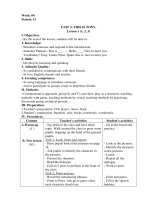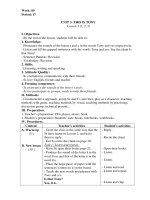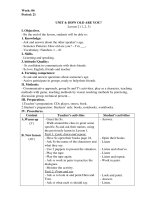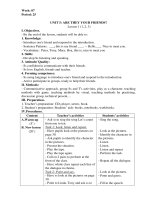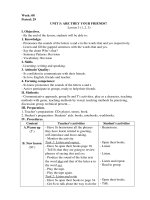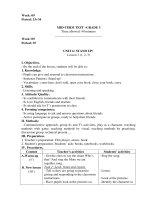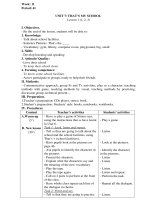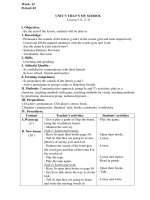Giáo án môn Tiếng Anh lớp 3: Tuần 34 (Theo Công văn 2345 của Bộ GD&ĐT)
Bạn đang xem bản rút gọn của tài liệu. Xem và tải ngay bản đầy đủ của tài liệu tại đây (400.67 KB, 8 trang )
Week: 34
Period: 131
UNIT 20: WHERE’S SA PA?
Lesson 3 (1, 2, 3)
I. Objectives.
By the end of the lesson, students will be able to:
1. Knowledge:
Pronounce the letter cluster ar in far and or in north.
Listen and fill the gapped sentences with the words far and north.
Say the chant Where’s Ba Vi?
Sentence Patterns: Revision
Vocabulary: Revision
2. Skills.
Listening and speaking.
3. Attitudes/ Quality:
Ss confident perform the chant.
Ss love their hometown, and country.
4. Forming competence:
Ss know pronounce the sounds of the letters ar and or
Ss know read and clap the hands with music.
Active participate in group.
II. Methods:
Communicative approach, group Ss and T's activities, play as a character, teaching
methods with game, teaching methods by visual, teaching methods by practising,
discussion group, technical present....
III. Preparation.
1. Teacher’s preparation: CDs player, stereo, book.
2. Student’s preparation: Students’ aids: books, notebooks, workbooks.
IV. Procedures.
Content
Teacher’s activities
Students’ activities
Have ss ask and answer the
Sing the song.
A. Warm up
question about distance, using Is +
(5’)
(place) +near + (place)?Yes, it
is/No, it isn’t.
Monitor the activity.
Open their books.
B. New lesson Task 1: Listen and repeat.
Have Ss open their books page 68.
Listen.
(30’)
Tell Ss that they are going to review
phrases of saying far and north.
Listen.
Produce the sound of the letter ar in
the words far and that of the letter o
Listen and repeat.
in the word north.
Read in group.
Play the tape.
Play the tape again.
Open their books.
Task 2: Listen and write
Talk.
Have Ss open their books to page
68.
Listen and write.
Get Ss to talk about the way to do
the task.
Tell Ss that they are going to listen
and write the missing words in
dialogues 1 and 2.
Listen and check answer.
1.far 2. north
Ask Ss trade their answers within
pairs or groups for correction.
Ask 34 Ss to read their answers
aloud to the class
Listen and give comments.
Have the whole class repeat each
line of the dialogues.
Task 3: Let’s chant
Where’s Ba Vi?
Ask Ss to look at the chant in their
books.
Play the tape and ask Ss to listen.
Play the tape again.
Ask Ss to practice singing in
groups.
Call on one group to perform the
chant at the front of the class.
C. Production Summary the lesson
Tell pupils to read the part 1 again.
(3’)
D. Homework Do exercises in workbook, learn by
heart the new words and the pattern.
(2’)
Listen.
Trade their answers.
Read
Listen and give
comments.
Repeat all the phrases.
Look the chant.
Listen.
Listen and repeat.
Practice reciting.
Perform the chant (the
rest of the class recite along
and clap the rhythm.
Listen
*********************************************************************
Week: 34
Period: 132
UNIT 20: WHERE’S SA PA?
Lesson 3 (4, 5, 6)
I. Objectives.
By the end of the lesson, students will be able to:
1. Knowledge:
Practise asking and answering about the places.
Read the paragraph and answer the questions.
Write about where they live, using the guiding questions.
Talk about their favourite place.
Sentence Patterns: Revision
Vocabulary: Revision
2. Skills:
Develop speaking, reading and writing
3. Attitudes/ Quality:
Ss confident in communicate with their friends.
Ss protect to environment and know more about your places.
4. Forming competence:
Ss know using knowledge to do exercises.
Be selfconscious complete the exercises.
II. Methods:
Communicative approach, group Ss and T's activities, play as a character, teaching
methods with game, teaching methods by visual, teaching methods by practising,
discussion group, technical present....
III. Preparation.
1. Teacher’s preparation: CDs player, stereo, book.
2. Student’s preparation: Students’ aids: books, notebooks, workbooks.
IV. Procedures.
Content
Teacher’s activities
Students’ activities
Get 2 groups of six to the front of
Sing and act the chant.
A. Warm up
the class to perform the chant
(5’)
Where’s Sapa ?
Monitor the activity.
B. New lesson Task 1: Listen and repeat.(Review)
Have Ss open their books page 68.
Open their books
(30’)
Tell Ss that they are going to review Listen.
phrases of saying far and north.
Play the tape.
Listen.
Play the tape again.
Listen and repeat.
Play the tape again.
Read in group.
Task 2: Read and write.
Have Ss open their book page 69.
Open their books.
Tell Ss that they are going to read
Listen.
the test and answer the questions
about A Vung and his place.
Guide ss to do the task.
Read and write.
Read and do the task individually.
Monitor the activity.
Have Ss trade their answer in pair
Trade their answers.
for correction.
Call on some Ss to report their
Perform the task.
answers.
Listen and give comments.
Listen and give
Give correct answers:
comments.
Have the whole class read each
sentence in chorus.
Repeat all the phrases.
Task 3: Let’s write
Tell ss that they are going to answer
the questions about themselves.
Give ss time to do the task.
Go around offering help, if
necessary.
Check answers.
Task 4: Play game
Tell ss that they are going find a
photo of a city in Viet Nam and give
a presentation on the place they like.
Monitor the activity.
C. Production Summary the lesson
Tell pupils to read the part 1 again.
(3’)
D. Homework Do exercises in workbook, learn by
heart the new words and the pattern.
(2’)
Listen.
Do the task.
Check answers.
Work in pairs to ask and
answer questions about
their favourite places.
*********************************************************************
Week: 34
Period: 133
REVIEW 4
I. Objectives:
By the end of the lesson Ps will be able to:
1. Knowledge:
Perform their abilities in listening, speaking and writing related to the topics from
units 1620, using the phonics, vocabulary and sentence patterns they have learnt.
Vocabulary: review
Grammar: review
Listen and tick the correct pictures and/ or listen and number the pictures. (If time is
restrained, choose either Listen and tick or Listen and number.)
Read and fill the gapped paragraph, using the words provided.
Read and match the questions with the answers.
Look at the pictures and answer the questions.
2. Skills:
Develop Ss’ speaking and reading skills
3. Attitude/ Quality:
Be confident in communicating with friends/ teachers.
Love people, hometown and country.
4. Forming competence:
Cooperation (ready to help friends in pair work/ groupwork).
Selfstudy (can perform individual tasks and solve problems by themselves).
Use language to do listening, reading, writing and speaking tasks.
II. Methods:
Communicative approach, group Ss and T's activities, play as a character, teaching
methods with game, teaching methods by visual, teaching methods by practising,
discussion group, technical present....
III. Preparation.
1. Teacher’s preparation: CDs player, stereo, book.
2. Student’s preparation: Students’ aids: books, notebooks, workbooks.
IV. Procedures.
Content
Teacher’s activities
Students’ activities
Review the model sentences from Sing songs
A. Warm up
unit16 to unit 20
(5’)
B. New lesson 1. Listen and tick
Have pupils look at pictures 1, 2, 3, 4 Listen.
(30’)
and 5 on page 70 of the Student Book.
Give the identification of the Look and listen to T.
characters in the pictures and the
characters’ words. Tell pupils that they
are going to listen to the recording and
tick the pictures they hear. Guess the
answer
Play the recording 2 times pupils to Look, listen and tick the
listen and tick the boxes. Check their correct pictures.
guess. Compare the answer with the
partner.
Play the recording again pupils check Check the answers in
pairs.
their answers. T give the answer:
Ask some questions to ensure pupils’
comprehension of the listening text.
Answers: 1a ; 2 b ; 3a; 4b;5a.
2. Listen and number
Have pupils look at pictures a, b, c Look and listen to T.
and d on page 70 of the Student Book.
Elicit the identification of the Look, listen and number
characters in the pictures and the the correct pictures.
characters’ words. Tell pupils that they
are going to listen to the recording and
match the information they hear to the
pictures. They should number the
boxes. Guess the answer
Play the recording 2 times pupils to Check the answers in
listen and number the boxes. Check pairs.
their guess. Compare the answer with
the partner.
Play the recording again pupils check
their answers. T give the answer:
Ask some questions to ensure pupils’
comprehension of the listening text.
Answer: 1d. 2.a 3. c 4.c
3. Read and complete
T explains the situation and how to do
the exercise
Ask students to read the dialogue in
the book and fill the words given to
complete the dialogue. Work in pairs
to do the exercise then practice in pairs
in front of the whole class. The rest
listen to and give the remark.
Correct the pronunciation.
Answer: 1. Living room 2. reading
3. watching 4. playing 5. near
6. dog
4. Read and match
Whole class. Have pupils turn their
books to page 71. Tell pupils that they
are going to read the sentences to get
the information in order to match the
sentences to the sentences.
Pupils read the sentences
individually and do the task. Monitor
the activity and offer help when
necessary.
Pair works. Have pupils trade their
answers for correction.
Call on some pupils to report their
answers. The rest of the class listen
give comments.
Make a few questions to check
pupils’ comprehension of the
sentences.
Have the whole class read each
sentence in chorus to reinforce their
pronunciation.
Answer: 1.e 2. c 3. a 4.b 5. d
5. Look and say
Have pupils look at pictures 1, 2, 3
and 4. Elicit the characters in the
pictures and their names. Ask pupils to
guess and complete the speech
bubbles.
Model: Call on a pair. Allocate the
parts of the characters in the pictures
to the pupils. Ask them to ask and
Read, and listen to T.
Read and fill the gapped
paragraph with the words
provided.
Check the answers in
pairs.
Look, read and listen to
T.
Read the questions and
look at the pictures to
answer.
Check the answers in
pairs.
Follow T’s instructions.
Turn on pp. 72 & 73 to
read and listen. Answer
T’s questions.
answer. Using the pictures in their
books. Monitor the activity and offer
help. Correct pronunciation errors
(stress, assimilation of sounds,
C. Production intonation) when necessary.
Call on some pairs to perform their
(3’)
D. Homework task in front of the class. The rest of
the class observe and give comments.
(2’)
Have the whole class repeat all the
phrases in chorus to reinforce their
pronunciation.
*********************************************************************
Week: 34
Period: 134
SHORT STORY
CAT AND MOUSE 4
I. Objectives:
By the end of this lesson, students will be able to:
Get the idea of the story.
Read and listen to the short story.
Read and put the words in the correct order.
Read and match the rhyming words.
Read and fill a gapped conversation.
II. Teaching aids:
1. Teacher’s: book, a tape, pictures, puppets.
2. Students’: book, notebook.
III. Procedures:
Content
Teacher’s activities
Sing songs.
A. Warm up
(5’)
B. New lesson Task 1: Read and listen to the story.
Ask ss to look at the pictures.
(30’)
Tell ss that they are going to read
and listen to the story.
Play the tape and let the ss read and
listen.
Task 2: put the words in the correct
order.
Tell ss that they are going to put the
words in the correct order to make
Student’s activities
Sing songs.
Look at the pictures.
Listen
Listen.
sentence.
Give ss a few seconds to read the
text in silence, and check their
comprehension.
Give ss time to do the task.
Ask ss to swap and check their
answers before checking as a class.
Task 3: Match the rhyming words.
Tell ss that they are going to pair
the words that rhyme.
Give ss a few second to read the
text and check comprehension.
Give ss time to do the task.
Ask ss to swap and check their
answers before checking s a class.
Task 4: Read and write.
Tell ss that they are going to read
the text and fill the gaps.
Give ss time to do the task.
Ask ss to swap and check their
answers before checking s a class.
Assign a few pairs to read aloud the
dialogue.
Ask Ss read the story at home.
C. Production Summary the lesson
Tell pupils to read the part 1 again.
(3’)
D. Homework Do exercises in workbook, learn by
heart the new words and the pattern.
(2’)
Read the text.
Check their answers.
Listen.
Read the text.
Check their answers.
Listen.
Do the task.
Read aloud the dialogue.
Listen
*********************************************************************
